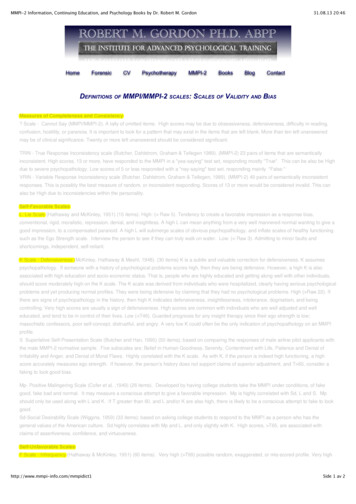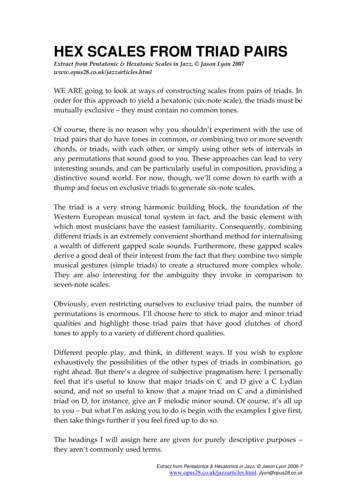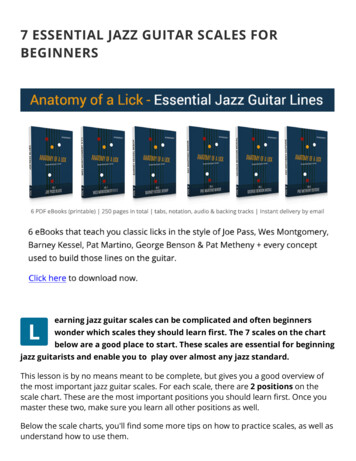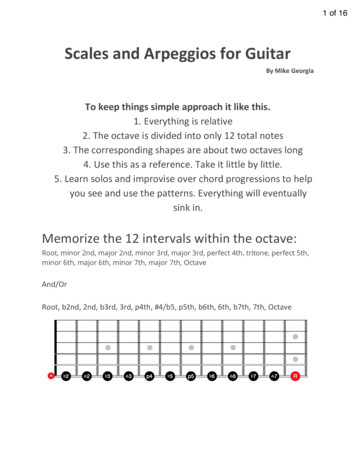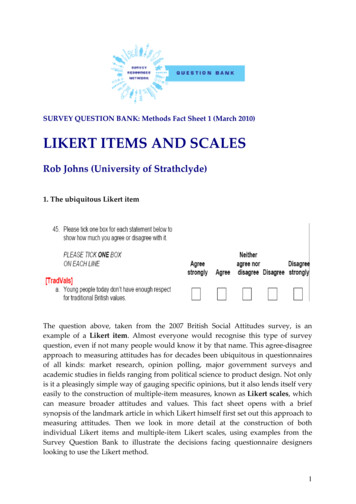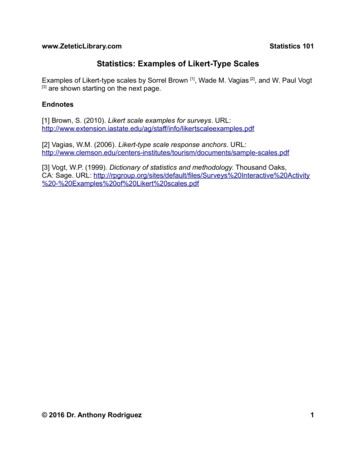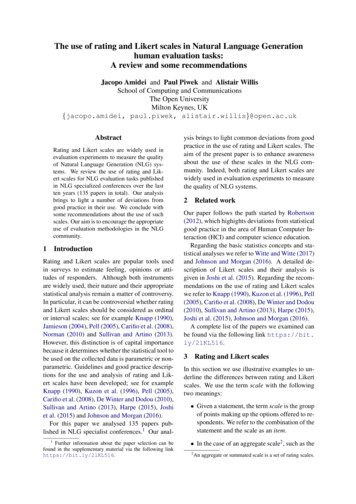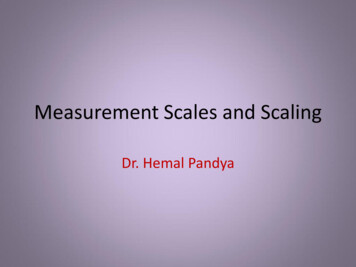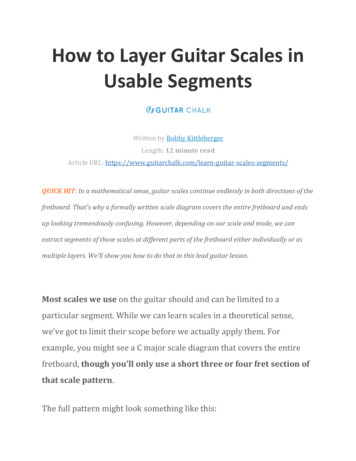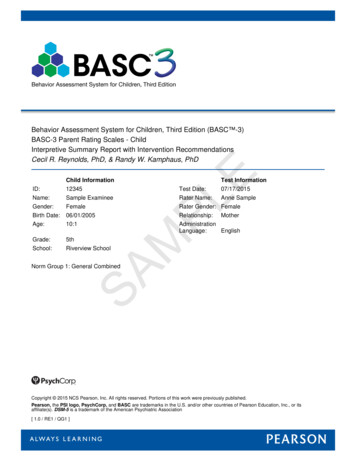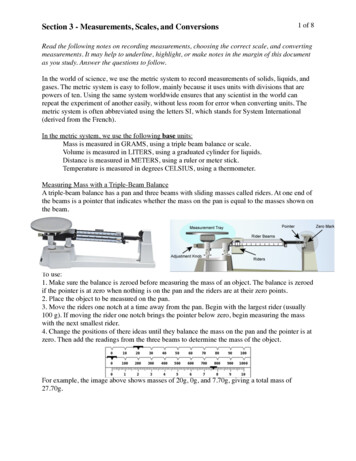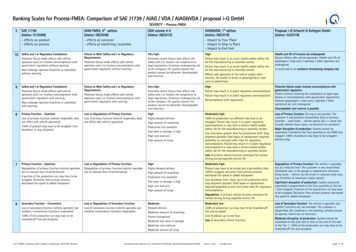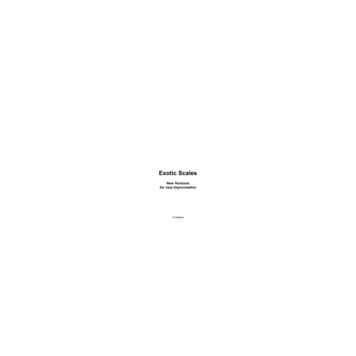
Transcription
Exotic ScalesNew Horizonsfor Jazz ImprovisationJ.P. Befumo
Exotic ScalesNew Horizonsfor Jazz ImprovisationJ.P. BefumoSuperiorBooks.com, Inc.
Exotic ScalesNew Horizons for Jazz ImprovisationAll Rights Reserved. Copyright 2002 J.P. BefumoNo part of this book may be reproduced or transmitted in any formor by any means, graphic, electronic, or mechanical, includingphotocopying, recording, taping, or by any information storage orretrieval system, without the permissionin writing from the publisher.This edition was produced for on-demand distributionby Replica Books.Softcover ISBN: 1-931055-60-2Printed in the United States of AmericaCover by SuperiorBooks.com, Inc.Copyright 2002
FOREWORDWhen I first took piano lessons as a child I learned to readmusic and follow the notation on sheet music. Although I learnedscales and was exposed to modes as part of my music instruction,composition and improvisation remained a mystery until my late teenswhen I took lessons from a jazz pianist during my freshman year incollege. Even then, although I could repeat patterns that I copiedfrom the instructor, and even modify those patterns slightly, trueimprovisation did not come easily, because I did not understand theunderlying musical structure.Despite my extensive formal education, I found that I stillcould not create a style of my own: I simply did not have a structurethat allowed me to explore options in a systematic and creative way.It was not until I studied a text on Jazz Improvisation and actuallypracticed using the various modes and progressions, that I began tograsp how to improvise, as well as how to add color and complexityto my playing.As a formally trained musician, I was at first skeptical of theapproach propounded in Exotic Scales. After all, ‘real’ jazz playersrarely approach improvisation from the perspective of applying a singlescale over an entire progression. Rather, they think in terms of changingscales and modes, and applying arpeggios over specific passages. WhenI sat down and carefully analyzed the results that emerge from applyingthese scales in the harmonic settings developed in the book, I was5
amazed to find that this is precisely what emerges, albeit from a ratherunconventional approach. Thus, as the reader works his or her waythrough the text and the numerous examples provided, it developsthat although the player is thinking in terms of a single, easy-tointernalize scale, what is really emerging is exactly the right arpeggio,mode, or scale for each chord in the developed progression.Musical theory is a complex subject, and one that lends itselfto many approaches and perspectives. Even relatively elementaryaspects of the subject, such as the diatonic modes, are a subject ofongoing discussion among musical scholars. For example, while onemight interpret the Aeolian mode as a diatonic major scale playedfrom the sixth degree, another musician will insist (equally correctly)on approaching it in terms of its intrinsic step/half-step structure. Inthis sense, Exotic Scales abstracts what would otherwise be anextremely complex set of techniques into their simplest form—anabstraction that, in all honesty, had never occurred to me until readingthis book.I am convinced that this is an approach that is particularlywell suited to the backgrounds and approaches employed by guitarists,although it will also be beneficial to any instrumentalist seeking toenter the world of jazz improvisation. A book like Exotic Scales wouldhave been a great time-saver in my own musical journey. It not onlypresents the use of modes other than the seven basic diatonic modesused in Jazz, but also presents a basic introduction to the use of modesthat would be valuable for a beginner with little music theory and fora more advanced student as a reference.I have been honored to have the opportunity to work directlywith Joseph Befumo in a number of capacities and to have made musicwith him. I have learned much from him, and I suspect that in readingthis book, you will also.Gerald Rudolph, Ph.D6
INTRODUCTIONAs a performing guitarist I’m always on the lookout for waysto separate my playing from the myriad of others who are milking theusual pentatonic minors, majors, and blues scales for all they’re worth.Exotic scales always seemed like an intriguing way to add some spiceto my solos, but every time I’d try one, it just seemed tosound so . . . outside. I knew enough theory to be able to design solosahead of time and make them fit just about any set of changes, buthaving grown up on improvisation, I favored an approach that wouldallow me to simply doodle over a progression, let the creativity flow,and sound good.Several years ago I encountered a series of books thatpurported to present just about every exotic scale there is. These,unfortunately, simply presented tables of intervals, leaving the readerto make what sense of them they could; an approach that seemedsomewhat less than helpful. Even though I knew some theory, it tooka good deal of effort to sit down, analyze these scales, and to come upwith harmonic environments within which they could be melodicallyapplied. It was precisely this effort, in fact, that led to the creation ofthis book.Even with an appropriate progression in hand, my initialattempts to turn these scales into something resembling music provedto be a rather tedious and frustrating exercise. By recording the stepsthat I followed, and the compositions that ultimately emerged, this7
book not only allows others to reproduce my results, but also providesa methodology through which readers can approach novel andworthwhile harmonic territories on their own.Because many of the finest musicians I know possess little orno theoretical background, I realized that in order to reach the widestpossible audience, I would have to assume little in the way of formalmusical training. You need not read music, nor have any knowledgeof musical theory to use this book. Everything you need to know isprovided. This is first and foremost a book about application andperformance, so only enough theory is included to allow theinformation presented to be understood and applied.In order to keep this book down to a manageable size, whilestill covering the essentials of this vast subject, only one mode of eachscale (with the exception of the Aeolian mode of the Diatonic Majorscale) is fully analyzed. The results for the subsequent modes aretabulated at the end of each chapter, leaving the reader to carry outthe full analysis as an exercise.All examples are provided in the popular MP3 format. Inaddition, the CD, available for purchase or for use without chargeonline at www.exotic-scales.com, contains PDF files of tablature, MIDIfiles of background arrangements to practice against, as well as sourcefiles for popular music programs, including Jammer , Finale , andCakewalk . Evaluation versions are also provided.8
Part I:Basic Harmonic Theory, Diatonic Scales and ModesThis section presents the basic information needed to fullyutilize the material that follows. This information is presented in ahands-on manner, by analyzing the major diatonic and natural minorscales that will be familiar to most players.9
Chapter 1—Harmonic FoundationsThe Evenly Tempered ScaleGuitars, pianos, and most other Western instruments aredesigned around the evenly tempered scale. The place where musicaltheory meets physics is the octave. An octave simply represents ahalving or doubling of frequency; that is, if you play an A 440 (that is,an A note whose frequency is 440 cycles per second) on a piano, thenext A note you encounter, moving from left to right, will have afrequency of 880 cycles per second. Move left instead, and the next Anote will have a frequency of 220 cycles per second. The more cyclesper second, the higher the pitch of the note. That’s all the mathematicswe’ll need for our understanding of musical theory.Our basic Western scale divides each octave into twelve equalsegments called steps. Hence, all of the scales we’ll be consideringare, in reality, simply different variations on this set of twelve notes.We can envision the evenly tempered scale as a series of twelvecells, each of which represents the smallest division we can use increating our music, as shown in Table 1-1.1234567Table 1-11189101112
After we get to twelve, the same sequence repeats itself anoctave higher. Playing these notes without restriction is known as thechromatic scale. If you pick up your guitar or sit down at your pianoand tap keys at random, you’ll be playing chromatically, and willprobably notice that the results are not terribly musical.Musicians, centuries ago, reached the same conclusion, andas a result, they came up with a scheme for playing some of the notesand not others. This compartmentalization is shown in Table 1-2:1CC#2DD#3E4FF#5GG#6AA#7BTable 1-2If you were to sing only the notes that have numbers abovethem, the result would be the familiar do-re-mi-fa-sol-la-ti-do thatwe all learned in kindergarten. This is known as the diatonic majorscale. Once again, the same sequence continues on either side, adinfinitum.Although this might not be immediately obvious, it’s actuallythe distances between the notes that gives the major scale itscharacteristic sound. That is, notice that there are two boxes betweenthe 1 and the 2, two boxes between the 2 and the 3, only one boxbetween the 3 and the 4, two boxes between the 4 and the 5, twobetween the 5 and the 6, two between the 6 and the 7, and one betweenthe 7 and the 1 of the next repetition. By convention, each group of 2boxes is known as a full step, and a distance of a single box is referredto as a half step. Hence, we can describe the diatonic major scale bythe following sequence of whole and half steps:Whole-whole-half-whole-whole-whole-half.One important thing to notice is that there are no half stepsbetween E and F, or between B and C. The significance of this willbecome clear later. If you have a piano or keyboard handy, you canreadily see how this is reflected in the fact that there are no black keysbetween the corresponding pairs of white keys.As shown in Table 1-3, this sequence of whole/half steps can12
be applied starting at any note, and the result will always be a F#6AA#BCC#DD#EFF#GG#7BB#C#DD#EE#F#GG#AA#Table 1-3As we’ll see throughout this book, changing the sequence ofsteps and half steps results in very different sounding scales! ExamineTable 1-3 and notice how the sharps and flats fall where they do becausethey have to in order to make the sequence of steps and half stepscome out right.Interval MapsA common way of identifying scales is the interval map. Thisis simply a sequence of seven numbers (for seven-note scales) indicatingthe number of semitones between each scale degree and the next. Forexample, the major scale shown in Table 1-3 is represented by thefollowing interval map:2-2-1-2-2-2-1By comparing this interval map to the sequence of steps andhalf steps illustrated in Table 1-2, the relationship will become clear.One result of this approach to characterizing scales is thatrotating the numbers illustrates the various modes of the same scale.(A mode simply refers to playing a scale from some note other than13
the first.). Thus, if the interval map of one scale can be related to thatof another by simply starting at some point other than the first number(and looping back to the beginning when you reach the end), then thetwo scales are actually different modes of a single scale. Throughoutthis book, the interval maps for each scale are shown in parentheseswhen the scale is introduced.Circles of Fifths and FourthsAlthough it might seem natural to order the keys alphabetically,as we did in Table 1-3, there are actually more logical and informativeways of arranging things. Let’s see how things work out if, instead,we follow each scale with the one beginning at its fifth degree; that is,since G is the fifth of C, that would be the next scale in our list.1CG2DA3EB4FC5GD6AE7B?Table 1-4Note that in Table 1-4 we have deliberately omitted the lastnote in the G scale. What note should we put there? If you guessed“F#” . . . give yourself a star! Remember, there is no half-step betweenE and F, and hence, F will naturally fall in that empty space betweenthe sixth and seventh degrees. Hence, the note we want for the seventhdegree of our G scale is an F#, right? This is why when you look at astaff for a piece of music in the key of G, there will be exactly onesharp on it, and that sharp will be on the line of the staff correspondingto the note F.Let try that again so we can get a feeling for the emergingpattern.The fifth degree of G is D, so that’s where we’ll start our nextline, using the notes from the G scale (including the F#). This is shownin Table 1-5:14
1CGD2DAE3EBF#4FCG5GDA6AEB7BF#?Table 1-5What note do you suppose we’re going to use for the seventhdegree? If you said “C#,” congratulations! Remember, once again,there is only a half-step between B and C, so the C would go in theempty space between the sixth and seventh degrees. If we look at asheet of music in the key of D, we’ll see that it has two sharps on thestaff—one on the F and one on the C.Let’s do that one more time.1CGDA2DAEB3EBF#C#4FCGD5GDAE6AEBF#7BF#C#?Table 1-6Since A is the fifth degree of D, that’s where we started ournext line in Table 1-6. We can readily see that the note G will fall inthat empty space between the sixth and seventh degrees, and hence,the note we want to put under the seventh degree is G#. Thus, the keyof A has three sharps, one on F, one on C, and one on G. This procedureof starting each new key from the fifth degree of the previous one,and adding a sharp on the seventh degree of the newly formed key, isreferred to as the circle of fifths, for reasons we shall come to shortly.First, however, now that we know where
online at www.exotic-scales.com, contains PDF files of tablature, MIDI files of background arrangements to practice against, as well as source files for popular music programs, including Jammer , Finale , and Cakewalk . Evaluation versions are also provided.
